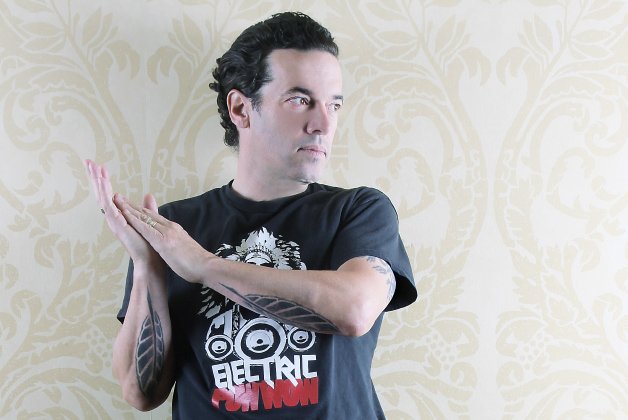
JOSEPH BOYDEN reading as a Governor General’s Award finalist, Monday (October 28), 8 pm, Fleck Theatre and speaking with other alumni at the UBC Anniversary Celebration, Tuesday (October 29), 8 pm, Brigantine Room. ifoa.org.
At a rammed book launch for another author, Joseph Boyden is making his way through the crowd to talk to me. Slowly. It has to be slowly, because he’s constantly being stopped by his admirers. People just want to touch his sleeve.
The Canuck novelist – Giller winner in 2008 for Through Black Spruce – is a literary rock star. He’s charismatic, moves almost like a dancer and, when you talk to him, makes you feel like you’re the most important person in the room.
No wonder that an hour and a half after his Word On The Street reading, there were still 50 fans lined up to talk to him, clutching their copies of his already bestselling The Orenda.
“It’s really great that these days people want to buy your book and read and talk to you. How can I say no?” he says, speaking on the phone a few weeks later in his Scottish-inflected accent – he’s part Scottish, Irish and Anishnabe – from his home in New Orleans.
As he graciously gives face time to anyone who wants it, it’s obvious that ego isn’t an issue.
“Being in a big family has taught me the danger of getting a big head,” he assures me. “It’s not considered right. Besides, there’s not enough oxygen in the room, you know.”
Generous with his time, generous with his accolades. There’s a reason he’s wearing a Tribe Called Red T-shirt for the NOW photo shoot.
“They’re the bomb,” he says enthusiastically. “They bridge the contemporary and the traditional in a way no one’s ever seen before, making traditional culture hip for young audiences – and not just aboriginal audiences. That’s what I want to do with my writing – bridge the gap between cultures that don’t necessarily see eye to eye.”
You can see that passion for connection in his GG-nominated The Orenda. In early 17th century Ontario, in the era of Champlain, three people – a captured Iroquois teen girl, her abductor from a hostile Huron tribe, and the Jesuit priest he’s also taken – gradually develop a grudging respect for each other that erodes their mutual distrust.
“I set out knowing I wasn’t going to present a rosy picture of three cultures singing to the sunset, because I knew that historically that wasn’t how it was,” says Boyden. “But I’m a peacemaker. I’ve always been the one who wants to resolve issues rather than inflame them and that’s where I am in this novel.”
It’s a value he takes personally.
“I look at [Prime Minister] Harper as my enemy, but you can’t make true progress unless you get past the one-dimensionality of that relationship.”
Boyden has a similar perception of his education. Born in Toronto, he was taught, fittingly, given his protagonist priest, by Jesuit teachers at Brebeuf College School.
“I did everything in my power to get kicked out of that school. I even cut my hair in a mohawk knowing that Brebeuf was tortured to death by the Mohawks. The authorities had to get the message. But I look back now and realize how passionate they were about teaching. And that my personal development and attention to detail didn’t come from nowhere.”
As part of his refusal to sugarcoat history, Boyden includes some very powerful passages detailing the torture meted out by aboriginals to their aboriginal enemies.

Kathryn Gaitens
“There isn’t that much of it, only a few pages,” Boyden points out, openly concerned that a reference to this brutality will turn people off. “But it was the elephant in the room and I had to address it if I was going to write this book properly. The Wendat [a Huron tribe] and haudenosaunee [Iroquois] did practise torture against each other, but it wasn’t an everyday occurrence.”
The Spanish Inquisition, he points out, was going on at the same time, so it wasn’t just these “noble savages” doing violence cruelty is a human trait.
“But why did they torture each other? The Europeans tortured to belittle and punish and demand, but the Huron and Iroquois practised it for opposite reasons. ‘I torture you to honour you. I see something you have, something I desire that I want to consume. So if I torture you and you don’t scream, you will live forever.’
“The violence is about creating a three-dimensional world. We’ve had enough romanticizing going on. We’ve got the old stories – The Last Of The Mohicans, Black Robe.”
He isn’t buying the idea that Idle No More gets better traction if First Nations are idealized.
“Idealization is shortsighted. As soon as outsiders get into the trenches or go to the communities, they see the garbage flying around and the poorly made houses. They don’t see the warmth and beauty and the intelligence of these people. You can romanticize First Nations, but then as soon as the reality hits you, the first thing you want to do is run.
“The way to make things right is to look at them as realistically as you can.”
Boyden thought he was writing about history, and it’s only in hindsight that he sees the contemporary resonances.
“Look at how the environment and the economics can’t be separated from each other. Look at the tar sands and how we want to build our economies on the back of the environment. Then look at the fur trade. It was wiped out because they wiped out the animals in the chase for profits.
“That’s exactly what we’re doing now with the tar sands.”
susanc@nowtoronto.com | @susangcole













